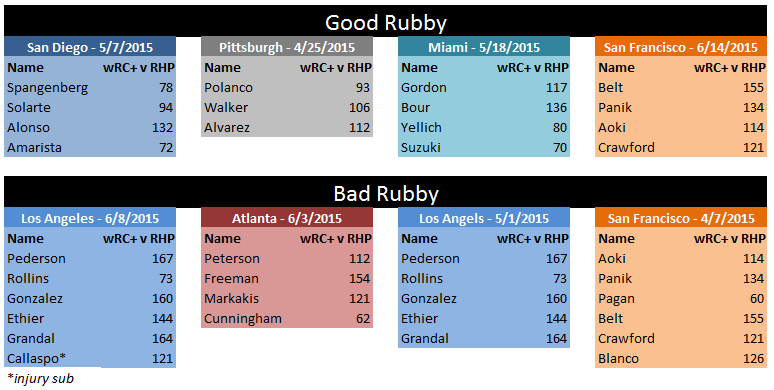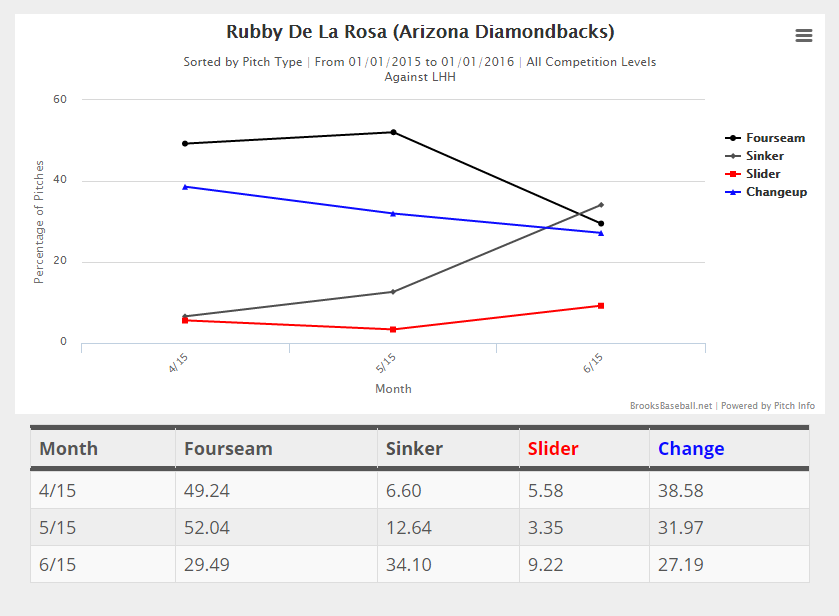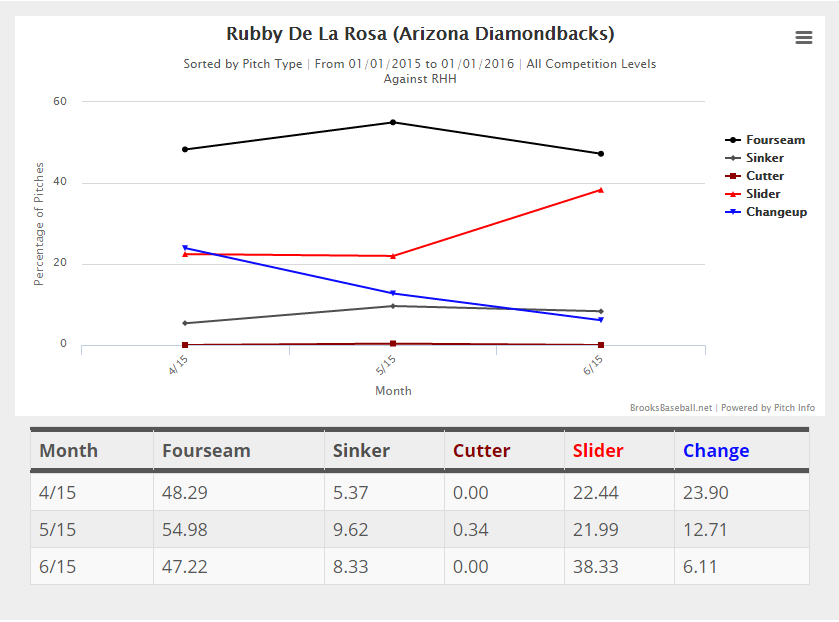What’s Behind Bad Rubby?
If you look at ERA, Rubby De La Rosa has been pretty bad. That’s usually what we think anyways when we see an ERA hovering around five. And if that’s of concern to you, perhaps you’ve also asked yourself why he’s even still in the rotation. Survivorship is a big part of it – he hasn’t missed a start – but he’s also the team’s second most valuable starter this season since the competition hasn’t been all that fierce (Robbie Ray is right on his heels despite throwing 75% fewer innings). Advanced metrics like De La Rosa more than ERA does: he’s got a 4.28 FIP, a 3.40 SIERA and a 3.32 xFIP. Those numbers aren’t bad and neither is Rubby De La Rosa. Sometimes.
We’ve joked about it on The Pool Shot, but there seems to be two very distinct Rubbys. Because I’m not very clever and because the monikers work, we’ll call them “Good Rubby” and “Bad Rubby”. Let’s take a look at his starts through the lens of Game Score, an easy-to-use metric created by Bill James, and track both Rubbys.
Clearly there’s been more Bad Rubby than Good Rubby this year. You could argue that there are some So-So Rubby starts in there, but that isn’t a kind of Rubby we’re searching for here. This exercise was binary and there’s a lot of Bad Rubby above. But when he’s been on, he’s been really good. Some of those starts are pretty damn excellent. So either he’s only capable of only ripping off a good start every once in a while, or there’s something else going on.
With this kind of volatility, the first place one might look is splits. Luckily for this researcher, the answer was brutal obvious. Observe:
Rubby De La Rosa is very good against right-handed hitters and very bad against left-handed ones. It’s a very simple case of platoon splits that are harming him. Across the board, whether we’re looking at OBP, strikeouts, homers, you name it, lefties are doing damage while he’s been good against righties. That’s one reason why I think there’s a chance he still ends up a reliever long-term, because every time he’s on the mound, teams stack their lineups full of lefties.
Let’s take a look at four good starts and four bad starts from Rubby. Included for each is the number of left-handed (and switch) batters that De La Rosa faced from the starting lineup (pinch hitters excluded), along with their season wRC+ against right-handed pitching.
In each of Rubby’s good starts highlighted, he faced no more than four lefties, and against Pittsburgh, he faced only three. That obviously bodes well for him. By facing fewer lefties, he was less-exposed. And even within those starts, the lefties he did face weren’t necessarily great, with the start against San Francisco on June 14th withstanding.
In his poor starts, things changed. He faced six lefties twice, five once and four once. Also, the caliber of left-handed hitter is far better on average in his poor starts (Good Rubby Average wRC+: 107.6, Bad Rubby Average wRC+: 128.4). He’s facing more lefties, who are better hitters against righties when he’s getting beaten around the yard. This seems like a pretty simple finding and not one that would necessarily surprise us.
So, maybe the monikers of Bad Rubby and Good Rubby don’t apply. Even though the results have been binary, they appear to be more of a factor of how opposing teams are constructing their lineups and less to do with how Rubby De La Rosa is throwing the baseball. Sure, there are times when he’s especially sharp and times when he’s especially not, but what’s killing him is lineup card, not so much his pitchability as a starting pitcher.
But if Rubby is going to remain a starter in major league baseball, he’s going to have to make some kind of change against lefties. He can’t continue get his ass kicked by left-handers even though he may never solve them entirely. There has to be a way to limit the damage. Lo and behold, it would appear that the team has already been working on a potential solution for a month or so: throw fewer four-seamers to lefties and use the sinker more often instead.
Notice the change in the usage of the two pitches against left-handed hitters (black line is four-seamers, grey line is sinkers):
And just to verify that this is lefty-specific, take a look at his chart against right-handed hitters and notice how the usage of the sinker remains virtually unchanged.
Rubby is who he is, there was no way he was going to do something radically different with his mechanics or his stuff to get lefties out. But, he could go back to existing toolbox and redistribute the usage of those tools. Apparently that’s what has happened, and while it hasn’t made him harder to hit for lefties per se, it has changed how lefties hit him. Let’s take a quick look at his batted ball distribution by month against lefties.
The sinker has done its job. He’s staying close in line drives, but has traded fly balls for grounders in a big way since going with the sinker. That doesn’t mean, however, that he’s been harder to hit. His batting average against is highest in June at .361. Ground balls have a higher BABIP than fly balls do, but they also never turn into home runs, and maybe that’s what the team is trying to limit. Keep the ball in the yard, make the other team go station-to-station, give Rubby a chance to move through the lefties to get to the righties in the lineup without allowing too much damage along the way (his sinker has maintained a lower ISO Against all season as compared to his four-seamer).
I can’t really argue with that if that’s what they’re attempting, because the alternative is just so obviously ineffective. Without an answer for lefties, Rubby looks like a bullpen arm who’s pitching in the rotation. He could be brought in anywhere between the 7th and the 9th to get out a trio of right-handers almost at will. But if he’s going to stick in the rotation, he has to have answer to the left-handed bats that most teams are going to stack their lineups full of.
For now, they’re attempting to make the sinker work. It’s keeping the ball in the yard, but it’s also getting hit a lot. BABIP is volatile, though, so maybe some of those hits turn into outs here pretty soon. Who knows? At least they’re balls on the ground, something a stellar infield should be able to generate into outs on an above-average basis. And if the sinker can help eliminate some of the Bad Rubby and even give us more So-So Rubby, that’s fine, because keeping him in the rotation long-term is the best, most-valuable solution so long as he’s effective there.
*stats courtesy of FanGraphs, Baseball-Reference and Brooks Baseball*
6 Responses to What’s Behind Bad Rubby?
Leave a Reply Cancel reply
Recent Posts
@ryanpmorrison
 Congrats to @OutfieldGrass24 on a beautiful life, wedding and wife. He deserves all of it (they both do). And I cou… https://t.co/JzJtQ7TgdJ, Jul 23
Congrats to @OutfieldGrass24 on a beautiful life, wedding and wife. He deserves all of it (they both do). And I cou… https://t.co/JzJtQ7TgdJ, Jul 23 Best part of Peralta’s 108 mph fliner over the fence, IMHO: that he got that much leverage despite scooping it out… https://t.co/ivBrl76adF, Apr 08
Best part of Peralta’s 108 mph fliner over the fence, IMHO: that he got that much leverage despite scooping it out… https://t.co/ivBrl76adF, Apr 08 RT @OutfieldGrass24: If you're bored of watching Patrick Corbin get dudes out, you can check out my latest for @TheAthleticAZ. https://t.co/k1DymgY7zO, Apr 04
RT @OutfieldGrass24: If you're bored of watching Patrick Corbin get dudes out, you can check out my latest for @TheAthleticAZ. https://t.co/k1DymgY7zO, Apr 04 Of course, they may have overtaken the league lead for outs on the bases just now, also...
But in 2017, Arizona ha… https://t.co/38MBrr2D4b, Apr 04
Of course, they may have overtaken the league lead for outs on the bases just now, also...
But in 2017, Arizona ha… https://t.co/38MBrr2D4b, Apr 04 Prior to the games today, there had only been 5 steals of 3rd this season (and no CS) in the National League. The… https://t.co/gVVL84vPQ5, Apr 04
Prior to the games today, there had only been 5 steals of 3rd this season (and no CS) in the National League. The… https://t.co/gVVL84vPQ5, Apr 04
Powered by: Web Designers@outfieldgrass24
 Old friend alert https://t.co/H8CeVQ90fG, 14 hours ago
Old friend alert https://t.co/H8CeVQ90fG, 14 hours ago RT @kbernot: Drank a lot of exceptional beers this year. Here are my top 10, for @CraftBeerBrew. https://t.co/cSgsipgZdD, Dec 05
RT @kbernot: Drank a lot of exceptional beers this year. Here are my top 10, for @CraftBeerBrew. https://t.co/cSgsipgZdD, Dec 05 Piss off https://t.co/eb6nxEkWJt, Dec 03
Piss off https://t.co/eb6nxEkWJt, Dec 03 Not a moment too soon for a whole host of reasons https://t.co/Y4t76VWAAp, Dec 03
Not a moment too soon for a whole host of reasons https://t.co/Y4t76VWAAp, Dec 03 Congratulations to K.L. and the Hops! There's an emphasis around the organization about being more than just a base… https://t.co/seFcjgViLU, Dec 03
Congratulations to K.L. and the Hops! There's an emphasis around the organization about being more than just a base… https://t.co/seFcjgViLU, Dec 03
Powered by: Web Designers











Great piece Jeff. This kind of stuff is why I love this site. Thanks as always for your work.
Just glancing at the project line up for Ruby’s next start against the Rockies it looks like the two big challenges for him will be with be against Paulsen and Blackmon(Blackmon rakes RHP and Paulsen is strictly a platoon hitter for RHP). CarGo has an almost 50% groundball rate against righties so that doesn’t seem to ominous considering the main goal for Ruby is keeping the ball out of the air in Coors field. Obviously there is a lot more firepower in the Rockies lineup, i.e Tulo and my second favorite 3b, but it will be exciting to see how Ruby does against the LHB on Thursday. Plus, its De la Rosa v. De La Rosa which is exciting in its self!
[…] Slice it however you want, they’re just not very good. We can talk about Rubby De La Rosa’s good starts or the emergence of a better Jeremy Hellickson of late, but truth be told, these guys just aren’t […]
[…] lefties. Yeah– that makes the Dodgers especially dangerous for RDLR. If only someone had flagged that issue three months ago (nice, […]
[…] noted here, that make-or-break situation revolves around him being able to get lefties out. He was terrible with that chore last season. With massive platoon splits, De La Rosa was constantly victimized by opposite-handed hitters and […]
[…] type of gem that makes you kind of wonder why you ever doubted him. Maybe you never doubted him, but I sure as hell did. It’s been a frustrating ride for De La Rosa with enough troubling outings to put his future […]